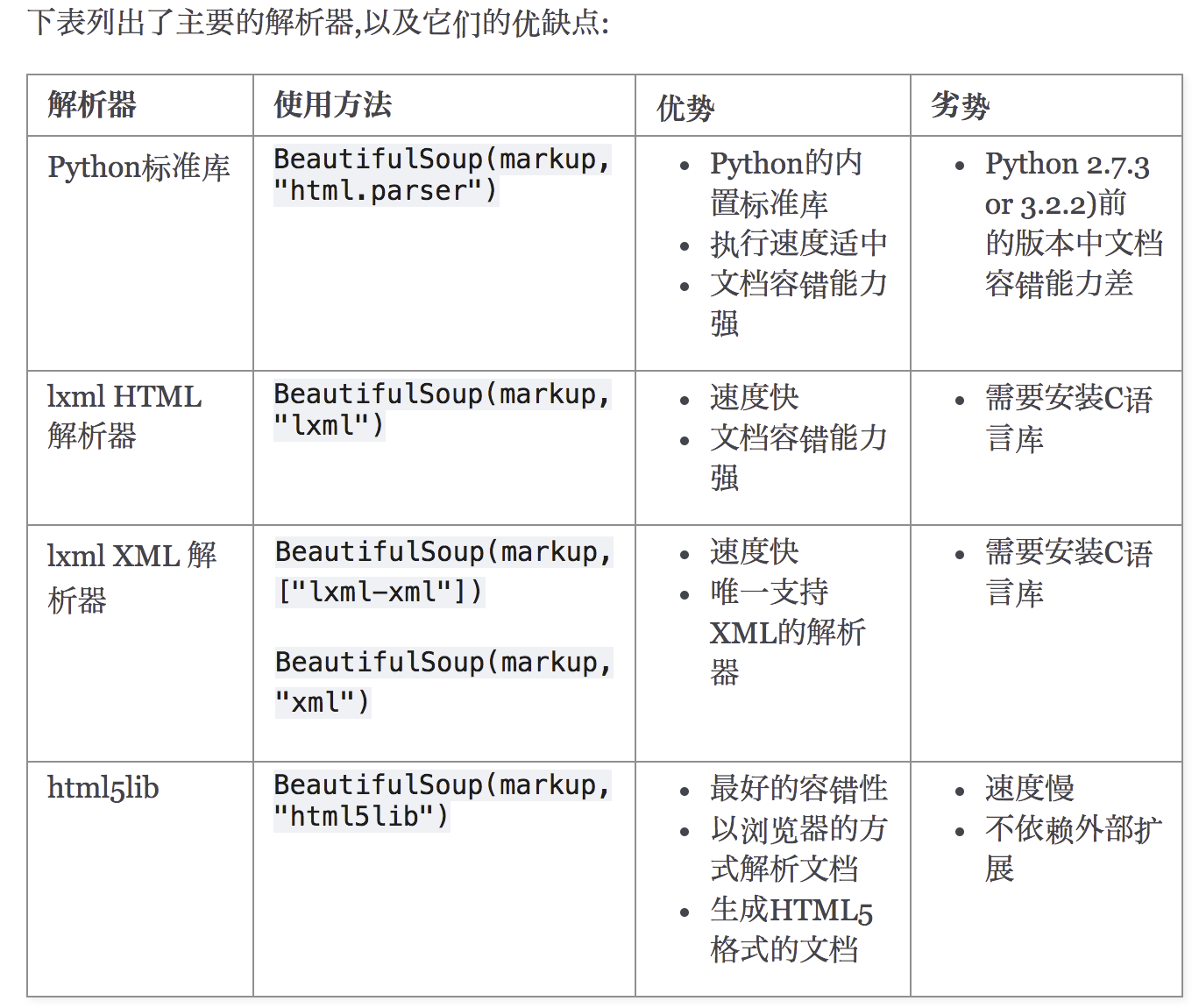1.正则表达式
单字符: . : 除换行以外所有字符 [] :[aoe] [a-w] 匹配集合中任意一个字符 d :数字 [0-9] D : 非数字 w :数字、字母、下划线、中文 W : 非w s :所有的空白字符包,括空格、制表符、换页符等等。等价于 [ f v]。 S : 非空白 数量修饰: * : 任意多次 >=0 + : 至少1次 >=1 ? : 可有可无 0次或者1次 {m} :固定m次 hello{3,} {m,} :至少m次 {m,n} :m-n次 边界: $ : 以某某结尾 ^ : 以某某开头 分组: (ab) 贪婪模式: .* 非贪婪(惰性)模式: .*? re.I : 忽略大小写 re.M :多行匹配 re.S :单行匹配 re.sub(正则表达式, 替换内容, 字符串)
2.Xpath解析
测试页面:
<html lang="en"> <head> <meta charset="UTF-8" /> <title>测试bs4</title> </head> <body> <div> <p>百里守约</p> </div> <div class="song"> <p>李清照</p> <p>王安石</p> <p>苏轼</p> <p>柳宗元</p> <a href="http://www.song.com/" title="赵匡胤" target="_self"> <span>this is span</span> 宋朝是最强大的王朝,不是军队的强大,而是经济很强大,国民都很有钱</a> <a href="" class="du">总为浮云能蔽日,长安不见使人愁</a> <img src="http://www.baidu.com/meinv.jpg" alt="" /> </div> <div class="tang"> <ul> <li><a href="http://www.baidu.com" title="qing">清明时节雨纷纷,路上行人欲断魂,借问酒家何处有,牧童遥指杏花村</a></li> <li><a href="http://www.163.com" title="qin">秦时明月汉时关,万里长征人未还,但使龙城飞将在,不教胡马度阴山</a></li> <li><a href="http://www.126.com" alt="qi">岐王宅里寻常见,崔九堂前几度闻,正是江南好风景,落花时节又逢君</a></li> <li><a href="http://www.sina.com" class="du">杜甫</a></li> <li><a href="http://www.dudu.com" class="du">杜牧</a></li> <li><b>杜小月</b></li> <li><i>度蜜月</i></li> <li><a href="http://www.haha.com" id="feng">凤凰台上凤凰游,凤去台空江自流,吴宫花草埋幽径,晋代衣冠成古丘</a></li> </ul> </div> </body> </html>
xpath 的使用:
1.下载:pip install lxml 2.导包:from lxml import etree 3.将html文档或者xml文档转换成一个etree对象,然后调用对象中的方法查找指定的节点 2.1 本地文件:tree = etree.parse(文件名) tree.xpath("xpath表达式") 2.2 网络数据:tree = etree.HTML(网页内容字符串) tree.xpath("xpath表达式")
xpath 表达式:
''' 属性定位: #找到class属性值为song的div标签 //div[@class="song"] 层级&索引定位: #找到class属性值为tang的div的直系子标签ul下的第二个子标签li下的直系子标签a //div[@class="tang"]/ul/li[2]/a 逻辑运算: #找到href属性值为空且class属性值为du的a标签 //a[@href="" and @class="du"] 模糊匹配: //div[contains(@class, "ng")] //div[starts-with(@class, "ta")] 取文本: # /表示获取某个标签下的文本内容 # //表示获取某个标签下的文本内容和所有子标签下的文本内容 //div[@class="song"]/p[1]/text() //div[@class="tang"]//text() 取属性: //div[@class="tang"]//li[2]/a/@href '''
#从本地文件中获取 etree1 = etree.parse("xpath.html") #网页字符串 etree2=etree.HTML(doc) # 1 属性定位 @ # //表示文档 / 表示下一层 # res1 =etree1.xpath('//a[@id="feng"]/text()') #['凤凰台上凤凰游,凤去台空江自流,吴宫花草埋幽径,晋代衣冠成古丘'] # res2 =etree2.xpath('//a[@id="feng"]/text()') #['凤凰台上凤凰游,凤去台空江自流,吴宫花草埋幽径,晋代衣冠成古丘'] # res = etree1.xpath('//div[@class="tang"]/ul/li/b/text()') #['杜小月'] # res = etree1.xpath('//a[@title="赵匡胤"]/@href') #['http://www.song.com/'] #2 层级定位和索引 # res = etree1.xpath('//div[@class="tang"]/ul/li[2]/a/@href') #3模糊匹配 # res = etree1.xpath('//a[starts-with(@title,"qin")]/@href') # res = etree1.xpath('//a[contains(@title,"qin")]/@href') #4 逻辑运算: # res = etree1.xpath('//a[@href="" and @class="du"]/text()') # print(res)
3.Beautiful Soup
Beautiful Soup 是一个可以从HTML或XML文件中提取数据的Python库。
提供一些简单的、python式的函数用来处理导航、搜索、修改分析树等功能。
安装:
pip3 install beautifulsoup4
解析器
Beautiful Soup支持Python标准库中的HTML解析器,还支持一些第三方的解析器,
如果我们不安装它,则 Python 会使用 Python默认的解析器,lxml 解析器更加强大,速度更快,推荐安装。
pip3 install lxml
html5lib 纯Python实现的 , html5lib的解析方式与浏览器相同
pip install html5lib
解析器对比:

beautifulsoup语法:
1.使用流程
- 导包:from bs4 import BeautifulSoup - 使用方式:可以将一个html文档,转化为BeautifulSoup对象,然后通过对象的方法或者属性去查找指定的节点内容 (1)转化本地文件: - soup = BeautifulSoup(open('本地文件'), 'lxml') (2)转化网络文件: - soup = BeautifulSoup('字符串类型或者字节类型', 'lxml') (3)打印soup对象显示内容为html文件中的内容
2.用法
(1)根据标签名查找 - soup.a 只能找到第一个符合要求的标签 (找到第一个a标签) (2)获取属性 - soup.a.attrs 获取a所有的属性和属性值,返回一个字典 - soup.a.attrs['href'] 获取href属性 - soup.a['href'] 也可简写为这种形式 (3)获取内容 - soup.a.string (标签套标签并列标签情况文本内容获取获取不到,一个的话可以获取到) - soup.a.text (可以获取到标签套标签并列的标签中的文档,可以拿到并拼接一起) - soup.a.get_text() (和.text 相同) 【注意】如果标签还有标签,那么string获取到的结果为None,而其它两个,可以获取文本内容 (4)find:找到第一个符合要求的标签(可以带其他参数) - soup.find('a') 找到第一个符合要求的 - soup.find('a', title="xxx") - soup.find('a', alt="xxx") - soup.find('a', class_="xxx") - soup.find('a', id="xxx") (5)find_all:找到所有符合要求的标签 - soup.find_all('a') - soup.find_all(['a','b']) 找到所有的a和b标签 - soup.find_all('a', limit=2) 限制前两个 (6)根据选择器选择指定的内容 select:soup.select('#feng') - 常见的选择器:标签选择器(a)、类选择器(.)、id选择器(#)、层级选择器 - 层级选择器: div .dudu #lala .meme .xixi 下面好多级 div > p > a > .lala 只能是下面一级 【注意】select选择器返回永远是列表,需要通过下标提取指定的对象
重点方法:
1.find_all()
#搜索文档树:BeautifulSoup定义了很多搜索方法,这里着重介绍2个: find() 和 find_all() .其它方法的参数和用法类似 html_doc = """ <html><head><title>The Dormouse's story</title></head> <body> <p id="my p" class="title"><b id="bbb" class="boldest">The Dormouse's story</b> </p> <p class="story">Once upon a time there were three little sisters; and their names were <a href="http://example.com/elsie" class="sister" id="link1">Elsie</a>, <a href="http://example.com/lacie" class="sister" id="link2">Lacie</a> and <a href="http://example.com/tillie" class="sister" id="link3">Tillie</a>; and they lived at the bottom of a well.</p> <p class="story">...</p> """ from bs4 import BeautifulSoup soup=BeautifulSoup(html_doc,'lxml') #1、name的五种过滤器: 字符串、正则表达式、列表、True、方法 #1.1、字符串:即标签名 print(soup.find_all('b')) #1.2、正则表达式 import re print(soup.find_all(re.compile('^b'))) #找出b开头的标签,结果有body和b标签 #1.3、列表:如果传入列表参数,Beautiful Soup会将与列表中任一元素匹配的内容返回.下面代码找到文档中所有<a>标签和<b>标签: print(soup.find_all(['a','b'])) #1.4、True:可以匹配任何值,下面代码查找到所有的tag,但是不会返回字符串节点 print(soup.find_all(True)) for tag in soup.find_all(True): print(tag.name) #1.5、方法:如果没有合适过滤器,那么还可以定义一个方法,方法只接受一个元素参数 ,如果这个方法返回 True 表示当前元素匹配并且被找到,如果不是则反回 False def has_class_but_no_id(tag): return tag.has_attr('class') and not tag.has_attr('id') print(soup.find_all(has_class_but_no_id)) #2、按照类名查找,注意关键字是class_,class_=value,value可以是五种选择器之一 print(soup.find_all('a',class_='sister')) #查找类为sister的a标签 print(soup.find_all('a',class_='sister ssss')) #查找类为sister和sss的a标签,顺序错误也匹配不成功 print(soup.find_all(class_=re.compile('^sis'))) #查找类为sister的所有标签 #3、attrs print(soup.find_all('p',attrs={'class':'story'})) #4、text: 值可以是:字符,列表,True,正则 print(soup.find_all(text='Elsie')) print(soup.find_all('a',text='Elsie')) #5、limit参数:如果文档树很大那么搜索会很慢.如果我们不需要全部结果,可以使用 limit 参数限制返回结果的数量.效果与SQL中的limit关键字类似,当搜索到的结果数量达到 limit 的限制时,就停止搜索返回结果 print(soup.find_all('a',limit=2)) #6、recursive:调用tag的 find_all() 方法时,Beautiful Soup会检索当前tag的所有子孙节点,如果只想搜索tag的直接子节点,可以使用参数 recursive=False . print(soup.html.find_all('a')) print(soup.html.find_all('a',recursive=False)) ''' 像调用 find_all() 一样调用tag find_all() 几乎是Beautiful Soup中最常用的搜索方法,所以我们定义了它的简写方法. BeautifulSoup 对象和 tag 对象可以被当作一个方法来使用, 这个方法的执行结果与调用这个对象的 find_all() 方法相同,下面两行代码是等价的: soup.find_all("a") soup("a") 这两行代码也是等价的: soup.title.find_all(text=True) soup.title(text=True) '''
2、find( name , attrs , recursive , text , **kwargs )
find_all() 方法将返回文档中符合条件的所有tag,尽管有时候我们只想得到一个结果.比如文档中只有一个<body>标签,那么使用 find_all() 方法来查找<body>标签就不太合适, 使用 find_all 方法并设置 limit=1 参数不如直接使用 find() 方法.下面两行代码是等价的: soup.find_all('title', limit=1) # [<title>The Dormouse's story</title>] soup.find('title') # <title>The Dormouse's story</title> 唯一的区别是 find_all() 方法的返回结果是值包含一个元素的列表,而 find() 方法直接返回结果. find_all() 方法没有找到目标是返回空列表, find() 方法找不到目标时,返回 None . print(soup.find("nosuchtag")) # None soup.head.title 是 tag的名字方法的简写.这个简写的原理就是多次调用当前tag的 find() 方法: soup.head.title # <title>The Dormouse's story</title> soup.find("head").find("title") # <title>The Dormouse's story</title>

from bs4 import BeautifulSoup import re html_doc =""" <html><head><title>The Dormouse's story</title></head> <body> <p id="my p" class="title"><b id="bbb" class="boldest">The Dormouse's story</b><span>123</span></p> <p class="story" name="deng">Once upon a time there were three little sisters; and their names were <a href="http://example.com/elsie" class="sister" id="link1">Elsie</a>, <a href="http://example.com/lacie" class="sister" id="link2">Lacie</a> and <a href="http://example.com/tillie" class="sister" id="link3">Tillie</a>; and they lived at the bottom of a well.</p> <p class="story">...</p> """ doc2=""" <div class="c1"> <p>123</p> <p>345</p> <div> </div> </div> """ soup = BeautifulSoup(html_doc,"lxml") # 1.拿到第一个a标签对象 res =soup.a # print(res) # 第一个a标签对象 #2.获取标签对象属性: # print(soup.a.attrs) # 拿到第一个a标签对象的所有属性 # print(soup.a.attrs["id"]) # # print(soup.a.attrs.get("id")) # print(soup.a["id"]) # 简写 #3.文本操作 # print(soup.a.text) #Elsie # print(soup.a.get_text()) #Elsie # print(soup.a.string) # print(soup.p.text) #The Dormouse's story123 # print(soup.p.string) # None #4. find_all() #name参数:四种name过滤器 # print(soup.find_all("a")) # 找所有a标签 # print(soup.find_all(["a","b"])) # 找所有a标签和b标签 # print(soup.find_all(re.compile("^b"))) # 找到所有 以 b开头的标签 #参数为函数名 # def has_class_but_no_id(tag): # return tag.has_attr('class') and not tag.has_attr('id') # print(soup.find_all(has_class_but_no_id)) # name=has_class_but_no_id # 1.属性参数: # print(soup.find_all(attrs={"class":"sister"})) # 简写 # print(soup.find_all('a',id="link2")) # # print(soup.find_all("a",class_="sister")) #2 文本参数 # print(soup.find_all("a",text="Tillie")) #3.limit参数 # print(soup.find_all("a",limit=2)) # 找到所有a标签取前2条 #4 recursive参数 # print(soup.find_all(recursive=True)) # 深度查询 # print(soup.find_all(recursive=False)) # 局部查 #5.find 等同于 soup.a # print(soup.find("a")) # 等同于 soup.a # find参数和find_all完全一样 ############select######## # 这个selector等同于css选择器 # print(soup.select(".sister")) # print(soup.select("#link1")) # print(soup.select("[name='deng']")) # for i in soup.select("body a"): # print(i["id"])
